The 11-mile-long Loop Road through Cades Cove in Great Smoky Mountains National Park is scheduled to be closed Wednesday and part of Thursday for bug spraying operations, according to park officials.
If the weather cooperates, technicians will take those days to treat hemlock woolly adelgid-infested hemlock trees with a horticultural oil sprayed from large truck-mounted units as they have been doing since 2004. In the event of heavy rain or freezing weather, the operation will be rescheduled.
To check the status of the road closure, visitors can call the park’s general information number at 865/436-1200.
During the full closure on December 1st, only hikers will be allowed to travel the Loop Road, according to park officials. Bicyclists will not be allowed to enter the Loop Road for safety reasons since there will be heavy equipment on the road, making it unsafe for bicycling. Park personnel will be working at the entrance and exit areas of the Loop.
The spraying operation on December 2nd will only impact the western end of the Loop Road. Motorists and cyclists will be able to enter the loop as they normally would, but will have to detour across the loop via Hyatt Lane (the second gravel crossroad) to exit Cades Cove. Hikers can continue through the closed portion. The detour will shorten the length of the trip to an 8-mile tour of Cades Cove.
The Hyatt Lane bypass will eliminate access to the Cades Cove Visitor Center and Cable Mill area as well as the several trailheads located on the western end of Cades Cove: Abrams Falls, Cooper Road, Rabbit Creek, and Wet Bottom Trails, and Gregory Ridge trailhead.
As part of the park’s control efforts of the hemlock woolly adelgid, actions include spraying hemlock trees with the oil/soap application in high-use developed areas that are easily accessible by vehicles such as Cades Cove, campgrounds, picnic areas and along roadsides.
Jesse Webster, the park's hemlock woolly adelgid project coordinator, said that “in addition to the spraying method, the park also employs systemic insecticidal treatments and biocontrol insects to reduce the impacts of the nonnative insect."
"Recent research is showing many positive effects in areas of these treatments, despite the noticeable decline of tree vigor and mortality throughout the park,” said Mr. Webster.




Add comment